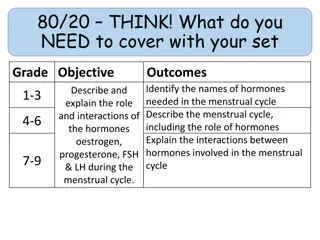Understanding Factors Influencing Estrus Cycle Length in Veterinary Science
Factors affecting the length of estrus cycle in animals, such as luteolysis, endocrine control, release of PGF2, and hormonal regulation, play crucial roles in determining the cyclicity and fertility of female animals. This comprehensive study delves into the intricate mechanisms involved in estrus
0 views • 17 slides
Endocrinological Aspects of Pregnancy: Hormones, Functions, and Synthesis
During pregnancy, endocrinological structures like the corpus luteum and placenta play vital roles in the production of hormones such as progesterone and estrogens. Progesterone maintains pregnancy by controlling essential functions like endometrial differentiation, myometrial quiescence, and local
4 views • 15 slides
Understanding Reproduction in Livestock and Poultry Management
This course delves into the intricate processes of reproduction in farm animals and poultry, covering stages like proestrus, estrus, metestrus, diestrus, and anestrus. It explores the roles of hormones like testosterone, estrogen, progesterone, relaxin, and oxytocin in regulating reproductive functi
0 views • 51 slides
Understanding Breast Development and Changes in Females
The breast, a vital organ in the upper ventral region of the torso, undergoes significant changes during puberty, the menstrual cycle, pregnancy, and milk production. These changes are driven by hormonal fluctuations, primarily estrogen and progesterone, resulting in the growth of milk ducts, format
0 views • 68 slides
Understanding the Hormones in the Menstrual Cycle
Explore the intricate role of hormones in the menstrual cycle, including the names and functions of key hormones like oestrogen, progesterone, FSH, and LH. Learn how these hormones interact and change throughout the cycle, influencing ovulation and menstruation. Dive into activities and resources to
6 views • 19 slides
Understanding Galactopoiesis and Milk Ejection in Veterinary Science
Galactopoiesis is the process of maintaining lactation in animals, involving hormones like prolactin, GH, cortisol, PTH, insulin, and oxytocin. This process also includes the role of progesterone, estrogen, and other hormones in milk production and release. Milk ejection, facilitated by oxytocin, in
0 views • 5 slides
Understanding the Menstrual Cycle: Phases and Hormonal Regulation
Menstruation is a natural process where the uterine lining sheds accompanied by bleeding in monthly cycles. The menstrual cycle consists of three phases - Follicular, Ovulatory, and Luteal - regulated by hormones like estrogen and progesterone. This cycle starts with menstruation, followed by the re
0 views • 11 slides
Understanding Induction of Parturition in Mammals
Induction of parturition in mammals involves the essential roles of progesterone, luteal regression, fetal cortisol, and the shift from progesterone to estrogen. This process is crucial for saving the lives of both the dam and fetus. Corticosteroids like dexamethasone and flumethasone are commonly u
0 views • 10 slides
Understanding Menstruation and Ovulation Cycle in Women
Menstruation, the cyclic uterine bleeding, is a result of hormonal interplay. It signifies ovarian events controlled by the hypothalamic-pituitary axis. The menstrual cycle, spanning from one period to the next, involves the release of ova and hormones like estrogen and progesterone. Menstruation ty
0 views • 49 slides
Understanding Puberty: A Guide for Girls
Puberty is a significant stage in a girl's life when her body undergoes various physical and emotional changes, preparing her for young adulthood. Hormones like estrogen, progesterone, and testosterone play vital roles in these transformations. Physical changes include growth spurts, body hair growt
0 views • 33 slides
Understanding the Physiology of Labor in Pregnancy
Labor, also known as parturition, is the process of uterine contractions leading to the expulsion of the fetus. Various hormonal changes, including increased estrogen levels, play a crucial role in triggering and regulating labor. The progression from a quiescent uterus to active contractions involv
0 views • 29 slides
Physiology of Labor: Onset and Key Hormonal Changes
Labor, or parturition, involves uterine contractions leading to the fetus's expulsion. Factors triggering labor include hormonal changes like increased estrogen and decreased progesterone, which stimulate uterine muscle activity. Telocytes play a role in spontaneous uterine activity, while oxytocin
0 views • 36 slides
Overview of the Female Reproductive System and Menstrual Cycle
The female reproductive system consists of organs like the vagina, uterus, ovaries, and fallopian tubes, which play vital roles in reproduction. Hormones like estrogen and progesterone regulate various processes such as ovulation, menstruation, and pregnancy. Menstruation is part of the menstrual cy
0 views • 7 slides












